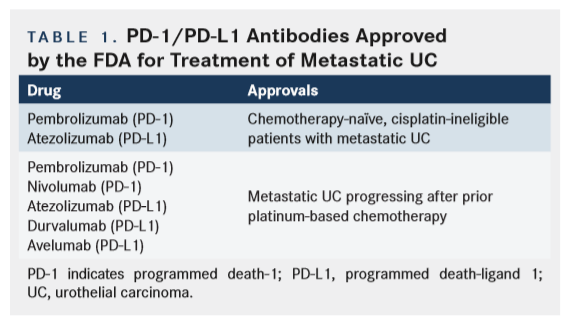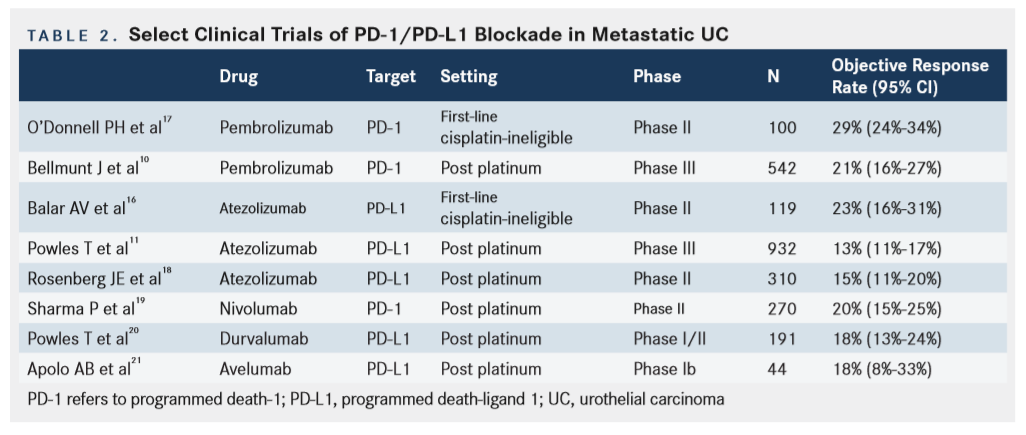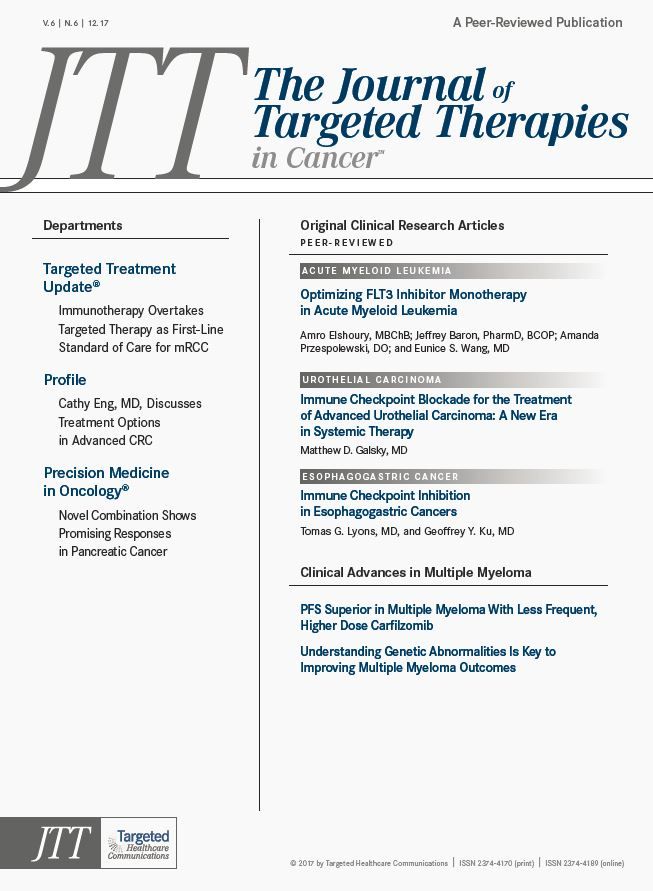Immune Checkpoint Blockade for the Treatment of Advanced Urothelial Cancer: A New Era in Systemic Therapy
The emerging arena of checkpoint inhibitors and immunotherapy in the treatment of urothelial carcinomas is explored and discussed.
Matthew D. Galsky, MD
Abstract
In this review, the emerging arena of checkpoint inhibitors and immunotherapy in the treatment of urothelial carcinomas is explored and discussed. In particular, the article covers the recent groundbreaking data in this space. As immunotherapies become more popular and clinically available, and more data emerge in support of them, it is essential to understand the science and the justification for using these agents in clinical practice.
Introduction
Metastatic urothelial cancer (UC) is a relatively chemotherapy-sensitive malignancy. With contemporary cisplatin-based combination chemotherapy regimens, objective responses are achieved in approximately 50% to 60% of patients and complete radiographic responses are achieved in approximately 10% to 20% of patients.1Unfortunately, response durations are typically short with only 5% to 10% of patients achieving durable disease control.
Decades of clinical trials exploring modifications of cytotoxic regimens, including the use of different or more drugs, demonstrated that a therapeutic plateau had been reached with conventional chemotherapeutic agents, highlighting the need for novel approaches. Central to the immune system is a set of inhibitory pathways regulated by proteins commonly referred to as immune checkpoints among which cytotoxic T-lymphocyte-associated protein 4 (CTLA-4), programmed death-1 (PD-1), and the programmed death ligand 1 (PD-L1) are the most well characterized.2Instead of a dysfunctional immune system as a general explanation of the lack of effective anticancer immune responses in patients with cancer, it is now understood that in at least a subset of patients, these immune checkpoints are co-opted by cancers to dampen antitumor immunity. Data in model systems, and in patients, now demonstrate that the administration of blocking antibodies to these checkpoints can overcome such adaptive immune resistance.
Clinical Experience With Single-Agent Immune Checkpoint Blockade in UC
AntiCTLA-4 antibodies were the first immune check- point inhibitors to be widely explored in cancer, and ipilimumab (Yervoy) is approved for the treatment of metastatic melanoma by the FDA. Studies in syngeneic mouse model systems of bladder cancer have demonstrated anticancer activity providing a rationale for clinical testing of CTLA-4 blockade.3Despite such data, there have been very few completed clinical trials exploring CLTA-4 blockade in UC.
Bradley C. Carthon, MD, PhD, and colleagues performed a “window of opportunity” study of precystectomy ipilimumab in patients with invasive UC of the bladder as a means to study the pharmacodynamic effects of treatment; that is, the investigators compared changes in the immune microenvironment in the posttreatment cystectomy specimens with the pretreatment transurethral resection specimens.4Interestingly, in this study of 12 patients treated with 2 doses of ipilimumab prior to cystectomy, patients receiving a higher dose of ipilimumab demonstrated a robust infiltration of T cells in the posttreatment cystectomy specimen.
A phase II study explored treatment with 2 cycles of gemcitabine plus cisplatin followed by 4 cycles of gemcitabine, cisplatin, and ipilimumab in chemotherapy-naïve patients with metastatic UC.5 The combination regimen was devised based on the hypothesis that initial chemotherapy would induce the killing of cancer cells and the release of tumor antigen (ie, immunogenic cell death), which could then be exploited by introduction of immune checkpoint blockade.5
Although the overall outcomes of patients treated with this regimen were similar to historical controls treated with gemcitabine plus cisplatin alone, an exploratory analysis revealed an intriguing improvement in survival in the subset of patients demonstrating a post-ipilimumab increase in peripheral blood T cells compared with the subset not demonstrating such an increase. Though PD-1/ PDL1 rapidly surpassed CTLA-4 as an attractive therapeutic target in UC, several studies are now exploring combination regimens involving CTLA-4 blockade plus PD-1/PD-L1 blockade or are revisiting the potential role of single-agent CTLA-4 blockade.
In the initial phase I studies exploring PD-1 and PD-L1 antibodies, it was apparent early on that the spectrum of anticancer activity was broader than had been the experience of CTLA-4 blockade; objective responses were seen in cancers commonly considered “immune responsive,” such as melanoma and renal cancer, but also somewhat unexpectedly in other solid tumors such as nonsmall cell lung cancer.6,7These findings, as well as data demonstrating that tumor-infiltrating lymphocytes are prognostic in UC specimens, provided the impetus to expand phase I cohorts to include UC. Initial proofof-concept for PD-L1 and PD-1 blockade in UC came from expansion cohorts of phase I studies of atezolizumab (Tecentriq) and pembrolizumab (Keytruda), respectively.8,9Both studies demonstrated durable objective responses in a subset of heavily pretreated patients with metastatic UC, with a generally favorable adverse event (AE) profile compared with historical patients treated with cytotoxic chemotherapy, serving as the basis for much more extensive investigation.
As of May 2017, 2 PD-1 inhibitors, pembrolizumab (Keytruda) and nivolumab (Opdivo), and 3 PD-L1 inhibitors, atezolizumab, durvalumab (Imfinzi), and avelumab (Bavencio), have been approved by the FDA for the treatment of metastatic UC (Table 1). The datasets leading to approval of these therapies’ range from expansion cohorts of phase I studies to large randomized phase III studies (Table 2).

In patients with metastatic UC who progress after prior platinum-based chemotherapy, these trials have demonstrated objective response rates (ORRs) of approximately 15% to 20%. Although, unfortunately, the vast majority of patients with metastatic UC do not respond to PD-1/PD-L1 blockade, responses that do occur tend to be durable. That is, in most trials reported to date, the median duration of response had not been reached at the time the data were locked for analysis, with responses routinely lasting more than 1 to 2 years.
Two phase III trials have now been reported randomizing patients with metastatic UC who progress after platinum-based chemotherapy to PD-1/PD-L1 blockade versus standard-of-care chemotherapy with docetaxel (Taxotere). The KEYNOTE-045 clinical trial randomized 542 patients to receive either pembrolizumab or chemotherapy with a coprimary endpoint of progression-free survival (PFS) and overall survival (OS).10This trial demonstrated a significant improvement in ORR (21.1% vs 11.4%) and median OS (10.3 vs 7.4 months) with pembrolizumab whereas, there was no significant difference in PFS. IMvigor 211 was a larger, though similarly designed study, randomizing 931 patients with metastatic UC who progressed after prior platinumbased chemotherapy to atezolizumab versus chemotherapy.11Unfortunately, a survival benefit was not demonstrated in the biomarker-defined population, impairing the ability to interpret the study overall. Notably, atezolizumab was associated with a numerical improvement in survival compared with chemotherapy in the overall study population.
Currently, there are no studies comparing different PD-1 and/or PD-L1 inhibitors and such prospective randomized trials are unlikely to occur. Within the limitations of cross trial comparisons, the antitumor activity (Table 1) and AE profiles of the available PD-1 and/or PD-L1 inhibitors are remarkably similar and aside from different levels of evidence, there are no clear data to guide the use of a particular agent.
Additionally, 2 large single-arm phase II trials have also demonstrated the activity of PD-1/PD-L1 blockade as first-line treatment for cisplatin-ineligible patients with metastatic UC. Although cisplatin- based chemotherapy is standard first-line treatment for patients with metastatic UC, a large proportion of patients are deemed “cisplatin ineligible” because of borderline performance status and/or comorbidities such as renal impairment, hearing loss, and peripheral neuropathy.12,13
Carboplatin-based chemotherapy has typically been administered in this setting but is associated with inferior outcomes compared with cisplatinbased combinations and is associated with an unfavorable toxicity profile.14,15Therefore, PD-1/PD-L1 blockade has been explored in this setting given the unmet need. In the IMvigor 210 study, atezolizumab was explored in a cohort of 119 chemotherapy- naïve cisplatin-ineligible patients with metastatic UC yielding a response rate of 23% (95% CI, 16%31%).16KEYNOTE-052 was a similarly designed trial, enrolling 270 patients, and reporting an ORR of 29% (95% CI, 24%-34%).17As demonstrated in trials exploring patients with cisplatin- resistant metastatic UC, these responses were generally prolonged, leading to the integration of such treatment as a standard option for chemotherapy-naïve cisplatinineligible patients.

Adverse Events
In addition to the durability of responses observed in clinical trials with PD-1/PD-L1 blockade, enthusiasm for this treatment class has also been garnered because of the generally favorable profile of these agents. Despite the use of slightly different eligibility criteria, different therapeutic antibodies, and exploration of different clinical disease states, the adverse event (AE) profile of the PD-1/PD-L1 antibodies explored across trials to date in metastatic UC has been quite consistent. In approximately 30% to 40% of patients, no treatment-related AEs have been noted. On the other hand, approximately 10% to 15% of patients across studies experience grade 3 or 4 AEs. The AEs of particular concern with PD-1/ PD-L1 inhibitors include immune-associated AEs linked to the underlying mechanism of action of this therapeutic class.
Although such AEs can potentially affect any organ, and mimic any previously described autoimmune disease, the more common immune-related AEs include dermatitis, endocrinopathies, colitis, and pneumonitis. When such AEs develop, cessation of treatment and initiation of corticosteroids is the general management strategy, with most AEs improving or resolving; however, there are specific immune-related events (such as hypophysitis and thyroiditis) that can improve with treatment, but generally don’t resolve and often require lifelong hormone replacement.
To put the potential adverse effects of PD-1/PDL1 blockade into perspective, the randomized phase III trials comparing chemotherapy with PD-1/PD-L1 blockade provide some context. In the KEYNOTE-045 study, 49.4% of patients developed a grade 3 to 5 AE with chemotherapy compared with 15% of patients treated with pembrolizumab.10With respect to specific immune-related AEs in patients randomized to pembrolizumab, any-grade thyroid abnormalities occurred in 9.4%, pneumonitis in 4.1%, colitis in 2.3%, and adrenal insufficiency in 0.4%.
Biomarkers Predictive of Response
The vast majority of trials exploring PD-1/PD-L1 blockade in metastatic UC have incorporated immunohistochemical testing of tumor specimens for expression of PD-L1 in an attempt to develop a predictive biomarker to select patients most likely to derive benefit from treatment. Interpretation of these data have been hampered by the use of different assays, different cut-points, quantification of expression in cancer cells versus immune cells versus both, and use of archival tissue typically derived from the primary tumor.
Despite these limitations, most early studies demonstrated that PD-L1based immunohistochemical testing could enrich the likelihood of patients responding to treatment yet responses achieved in patients with “negative” tests tempered enthusiasm for ultimate integration of testing into clinical decision making.9,16The story with PD-L1 testing, however, has become more complicated as larger randomized datasets have emerged. For example, in the KEYNOTE-045 randomized study of pembrolizumab versus chemotherapy, a survival benefit with pembrolizumab was observed regardless of PD-L1 expression.10
In the IMvigor 211 randomized study of atezolizumab versus chemotherapy, there was no benefit with atezolizumab demonstrated in the primary analysis of the high PD-L1 expression subgroup but a survival benefit was observed in the exploratory analysis of the total study population.11Together, these findings suggest that PD-L1 expression testing currently has limited clinical utility in metastatic UC and routine testing in the clinic is not recommended.
Several other potential biomarkers predictive of response to PD-1/PD-L1 blockade have been explored. As tumors harboring a large burden of somatic mutations are hypothesized to generate a greater number of potentially immunogenic antigens, higher tumor mutational burden as determined by using next-generation sequencing has been correlated with a higher likelihood of response to treatment.16,18
The molecular subtypes of UC defined by The Cancer Genome Atlas have also been explored as potential predictive biomarkers; however, analyses have demonstrated slightly inconsistent findings and have not identified a group with an extremely high or low likelihood of response.18,19Although combinations of biomarkers may ultimately improve the performance of response prediction tools, currently there are no tests with operating characteristics sufficient to routinely inform treatment decisions.
Present and Future Directions
Two major themes have emerged in the clinical development of PD-1/PD-L1 blockade in UC stimulated by the promise of the completed clinical trials and regulatory approvals: (1) exploring these therapies in earlier clinical disease states and (2) exploring combination regimens in an attempt to increase the proportion of patients who derive benefit. Large prospective trials with potentially practice-changing implications are now exploring PD-1/PD-L1 blockade as first-line treatment for metastatic disease either alone or in combination with chemotherapy or CTLA-4 blockade, in adjuvant treatment in patients at high risk of recurrence postcystectomy, and in the nonmuscle-invasive setting. The most advanced combination regimens to date include combinations of PD-1/PD-L1 blockade with cytotoxic chemotherapy or with CTLA-4 blockade, although such trials only scratch the surface of the novel regimens under investigation. In just a few years, the results of all these trials will undoubtedly change the way we treat patients with UC.
References
- Bellmunt J, von der Maase H, Mead GM, et al. Randomized phase III study comparing paclitaxel/cisplatin/gemcitabine and gemcitabine/cisplatin in patients with locally advanced or metastatic urothelial cancer without prior systemic therapy: EORTC Intergroup study 30987.J Clin Oncol. 2012;30(10):11071113. doi: 10.1200/ JCO.2011.38.6979.
- Pardoll DM. The blockade of immune checkpoints in cancer immunotherapy. Nat Rev Cancer. 2012;12(4):252-264. doi: 10.1038/nrc3239.
- Mangsbo SM, Sandin LC, Anger K, Korman AJ, Loskog A, Totterman TH. Enhanced tumor eradication by combining CTLA-4 or PD-1 blockade with CpG therapy.J Immunother. 2010;33(3):225-235. doi: 10.1097/CJI.0b013e3181c01fcb.
- Carthon BC, Wolchok JD, Yuan J, et al. Preoperative CTLA-4 blockade: tolerability and immune monitoring in the setting of a presurgical clinical trial.Clin Cancer Res. 2010;16(10):2861-2871. doi: 10.1158/1078-0432.CCR-10-0569.
- Galsky MD, Hahn NM, Albany C, et al. Phase II trial of gemcitabine + cisplatin + ipilimumab in patients with metastatic urothelial cancer.J Clin Oncol. 2016;34(suppl 2, abstr 357). http://ascopubs.org/doi/abs/10.1200/ jco.2016.34.2_suppl.357.
- Brahmer JR, Drake CG, Wollner I, et al. Phase I study of single-agent antiprogrammed death-1 (MDX-1106) in refractory solid tumors: safety, clinical activity, pharmacodynamics, and immunologic correlates.J Clin Oncol. 2010;28(19):3167-3175. doi: 10.1200/JCO.2009.26.7609.
- Topalian SL, Hodi FS, Brahmer JR, et al. Safety, activity, and immune correlates of antiPD-1 antibody in cancer.N Engl J Med. 2012;366(26):2443-2454. doi: 10.1056/NEJMoa1200690.
- Powles T, Eder JP, Fine GD, et al. MPDL3280A (anti-PD-L1) treatment leads to clinical activity in metastatic bladder cancer.Nature. 2014;515(7528):558-562. doi: 10.1038/nature13904.
- Plimack ER, Bellmunt J, Gupta S, et al. Safety and activity of pembrolizumab in patients with locally advanced or metastatic urothelial cancer (KEYNOTE-012): a non-randomised, open-label, phase 1b study.Lancet Oncol. 2017;18(2):212-220. doi: 10.1016/S1470-2045(17)30007-4.
- Bellmunt J, de Wit R, Vaughn DJ, et al. Pembrolizumab as second-line therapy for advanced urothelial carcinoma.N Engl J Med. 2017;376(11):1015-1026. doi: 10.1056/NEJ- Moa1613683.
- Powles T, Loriot Y, Duran I, et al. IMvigor 211: a phase III randomized study examining atezolizumab vs. chemotherapy for platinum-treated advanced urothelial cancer. Abstract presented at: EACR-AACR-SIC Special Conference 2017; June 24-27, 2017; Florence, Italy. Abstract 606.
- Galsky MD, Hahn NM, Rosenberg J, et al. A consensus definition of patients with metastatic urothelial carcinoma who are unfit for cisplatin-based chemotherapy.Lancet Oncol. 2011;12(3):211-214. doi: 10.1016/S1470-2045(10)70275-8.
- Galsky MD, Hahn NM, Rosenberg J, et al. Treatment of patients with metastatic urothelial cancer “unfit” for cisplatin-based chemotherapy.J Clin Oncol. 2011;29(17):2432- 2438. doi: 10.1200/JCO.2011.34.8433.
- Galsky MD, Chen GJ, Oh WK, et al. Comparative effectiveness of cisplatin-based and carboplatin-based chemotherapy for treatment of advanced urothelial carcinoma.Ann Oncol. 2012;23(2):406-410. doi: 10.1093/annonc/mdr156.
- De Santis M, Bellmunt J, Mead G, et al. Randomized phase II/III trial assessing gemcitabine/carboplatin and methotrexate/carboplatin/vinblastine in patients with advanced urothelial cancer who are unfit for cisplatin-based chemotherapy: EORTC study 30986.J Clin Oncol. 2012;30(2):191-199. doi: 10.1200/JCO.2011.37.3571.
- Balar A V, Galsky MD, Rosenberg JE, et al. Atezolizumab as first-line treatment in cisplatin-ineligible patients with locally advanced and metastatic urothelial carcinoma: a single-arm, multicentre, phase 2 trial.Lancet. 2017;389(10064):6776. doi: 10.1016/ S0140-6736(16)32455-2.
- O’Donnell PH, Grivas P, Balar AV, et al. Biomarker findings and mature clinical results from KEYNOTE-052: first-line pembrolizumab (pembro) in cisplatinineligible advanced urothelial cancer (UC).J Clin Oncol. 2017;35(suppl 15, abstr 4502). doi: 10.1200/JCO.2017.35.15_suppl.4502.
- Rosenberg JE, Hoffman-Censits J, Powles T, et al. Atezolizumab in patients with locally advanced and metastatic urothelial carcinoma who have progressed following treatment with platinum-based chemotherapy: a single-arm, multicentre, phase 2 trial.Lancet. 2016;387(10031):1909-20. doi: 10.1016/S0140-6736(16)00561-4.
- Sharma P, Retz M, Siefker-Radtke A, et al. Nivolumab in metastatic urothelial carcinoma after platinum therapy (CheckMate 275): a multicentre, single-arm, phase 2 trial.Lancet Oncol. 2017;18(3):312-322. doi: 10.1016/S1470-2045(17)30065-7.
- Powles T, O’Donnell PH, Massard C, et al. Efficacy and safety of durvalumab in locally advanced or metastatic urothelial carcinoma: updated results from a phase 1/2 open- label study.JAMA Oncol. 2017;3(9):e172411. doi: 10.1001/jamaoncol.2017.2411.
- Apolo AB, Infante JR, Balmanoukian A, et al. Avelumab, an anti-programmed death- ligand 1 antibody, in patients with refractory metastatic urothelial carcinoma: results from a multicenter, phase Ib study.J Clin Oncol. 2017;35(19):2117-2124. doi: 10.1200/JCO.2016.71.6795.

Survivorship Care Promotes Evidence-Based Approaches for Quality of Life and Beyond
March 21st 2025Frank J. Penedo, PhD, explains the challenges of survivorship care for patients with cancer and how he implements programs to support patients’ emotional, physical, and practical needs.
Read More